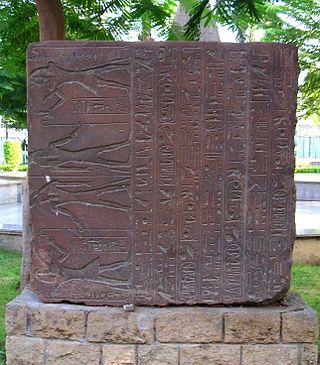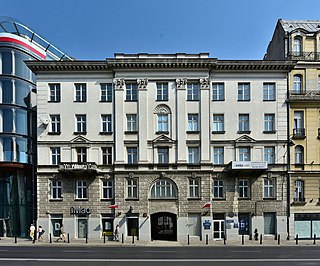Archaeological research
Exploration of the site began in 1984 as part of the Eski Mosul Dam Salvage Project, an international archaeological salvage operation organized by the Iraqi Directorate of Antiquities due to the building of a dam on the Tigris River. Excavations on Tell Raffaan and in its vicinity were conducted by an expedition from the Polish Centre of Mediterranean Archaeology University of Warsaw. [1] Piotr Bieliński directed the archaeological works, while Ryszard F. Mazurowski and Waldemar Chmielewski headed the field survey team, which identified Paleolithic sites on the hills surrounding the micro-region. [2] The Polish expedition also carried out work at the site of Tell Rijim, located in the same micro-region.
At its highest point, Tell Raffaan rose 6.5 meters above the level of the Tigris. [3] The research was conducted only in the eastern part of the tell since a modern cemetery occupied the western one. [2] Only one archaeological layer was identified, dating to the Early Uruk period (second half of the 4th millennium BC). [3] The excavations yielded numerous fragments of pottery as well as obsidian and flint tools. On the slope, there was a skeletal grave in stone setting, furnished with three undecorated cups similar to the pottery found in other parts of the site. [3] This part of the tell was badly eroded; no architectural remains were uncovered. [1]

The Diyala is a river and tributary of the Tigris. It is formed by the confluence of the Sirwan and Tanjaro rivers in Darbandikhan Dam in the Sulaymaniyah Governorate of Northern Iraq. It covers a total distance of 445 km (277 mi).

Kazimierz Józef Marian Michałowski was a Polish archaeologist and Egyptologist, art historian, member of the Polish Academy of Sciences, professor ordinarius of the University of Warsaw as well as the founder of the Polish Centre of Mediterranean Archaeology. He coined the term "Nubiology" to refer to the study of ancient Nubia.

Soba is an archaeological site and former town in what is now central Sudan. Three kingdoms existed in medieval Nubia: Nobadia with the capital in Faras, Makuria with the capital in Dongola, and Alodia (Alwa) with the capital in Soba. The latter used to be the capital of the medieval Nubian kingdom of Alodia from the sixth century until around 1500. E. A. Wallis Budge identified it with a group of ruins on the Blue Nile 19 kilometres (12 mi) from Khartoum, where there are remains of a Meroitic temple that had been converted into a Christian church.

Athribis was an ancient city in Lower Egypt. It is located in present-day Tell Atrib, just northeast of Benha on the hill of Kom Sidi Yusuf. The town lies around 40 km north of Cairo, on the eastern bank of the Damietta branch of the Nile. It was mainly occupied during the Ptolemaic, Roman, and Byzantine eras.

Faras was a major city in Lower Nubia. The site of the city, on the border between modern Egypt and Sudan at Wadi Halfa Salient, was flooded by Lake Nasser in the 1960s and is now permanently underwater. Before this flooding, extensive archaeological work was conducted by a Polish archaeological team led by professor Kazimierz Michałowski.

Marina, also Marina El Alamein , ancient Leukaspis or Antiphrae, is an upscale resort town catering mainly to the Egyptian upper class. It is located on the northern coast of Egypt, with an 11 km (6.8 mi) long beach, about 300 km (190 mi) away from Cairo, in the El Alamein area.

Tell Qaramel is a tell, or archaeological mound, located in the north of present-day Syria, 25 km north of Aleppo and about 65 km south of the Taurus mountains, adjacent to the river Quweiq that flows to Aleppo.

Nemrik 9 is an early Neolithic archeological site in the Dohuk Governorate in the north of modern-day Iraq.

The Polish Centre of Mediterranean Archaeology University of Warsaw operates as an independent research institute of the University of Warsaw under the present name since 1990. It is dedicated to organizing, implementing and coordinating archaeological research, both excavations and study projects, as well as conservation, reconstruction and restoration projects, in northeastern Africa, the Near East and Cyprus. Projects include sites covering a broad chronological spectrum from the dawn of civilization through all the historic periods of the ancient Mediterranean civilizations to Late Antiquity and early Islam. Tasks beside fieldwork include comprehensive documentation of finds, archives management and publication of the results in keeping with international research standards. The PCMA manages the Research Centre in Cairo and Polish Archaeological Unit in Khartoum.

Eski Mosul is a village in Mosul District, in present-day northern Iraq. Located just downstream from the Mosul Dam, Eski Mosul is the site of the ancient and medieval city of Balad.
Bahra 1 is an archaeological site in the Subiya region on the coast of Kuwait Bay (Kuwait) associated with the Ubaid culture. It is one of the earliest Ubaid culture settlements in the Persian Gulf region, about 5500–4900 BC.
Bijân Island is an island in the middle Euphrates, in the historical land of Suhum. It belongs to a group of islands on which archaeological sites have been recorded.
Subiya (Al-Subiyah) is a region in northern Kuwait on the north coast of Kuwait Bay (Kuwait), consisting of several micro-regions: Bahra, H3, Nahdain, Radha, Muhaita, Mughaira, Dubaij, and Ras al-Subiyah. The area features archaeological sites with tumuli graves, settlements, campsites, wells, and shell middens. Most of the tumuli date to the Early and Middle Bronze Age. Subiya is the location of the Silk City project, the project's first phase was launched in May 2019.
Tell Amarna is an archaeological site near the village Amarnah in northern Syria, on the west bank of the Euphrates.
Tell Djassa is an archaeological site in Syria, in the Khabur River basin, in the area of the Khabur Triangle in Upper Mesopotamia.
Tell Abu Hafur is an archaeological site in Syria, in the Khabur River basin, in the area of the Khabur Triangle in Upper Mesopotamia.
Tell Saadiya is a tell, or archaeological settlement mound, in Diyala Governorate (Iraq).
Tell Rad Shaqrah was a fortified rural settlement in Syria, in ancient Upper Mesopotamia. It is located on the northern bank of the Khabur River, about 15 kilometers from Hassake (Al-Hasaka).
Tell Rijim is an archaeological site in Iraq, in ancient Upper Mesopotamia, in the valley of the Tigris River, about 25 kilometers to the north-west of Eski Mosul.
Piotr Bielinski is a Polish Mediterranean archaeologist, professor of humanities, specializing in the archaeology of the ancient Middle East. His research interests include the art - especially glyptics - and architecture of Mesopotamia, Syro-Palestine, Anatolia, and the Persian Gulf from the Chalcolithic to the Bronze Age. He has led over a dozen Polish archaeological expeditions to the Middle East.








